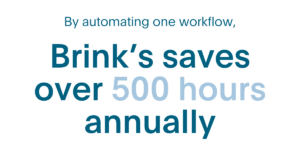
Brink’s Secures Scalability with PagerDuty Runbook Automation Self-Hosted

Size: 50,000+ employees
Industry: Logistics
Location: Virginia, United States
Customer Since: 2021
Brink’s, a global leader in cash management, secure logistics and payment solutions, helps businesses securely manage their money. The company operates over 16,000 secured trucks and serves customers in more than 100 countries.
Technology is a key component of Brink’s long-term corporate strategy to drive growth and ensure exceptional customer support. In recent years, the company saw an opportunity to modernize and mature its IT ecosystem. Teams were managing workflows manually, and spending too much time and money on repetitive tasks. Deployments, migrations, and changes in the IT environment were also time consuming and often inconsistent. The company needed more scalable solutions moving forward.

Identifying Toil
The engineering team audited their processes and identified challenges that impacted productivity and overall employee satisfaction.
One of these processes was distributing changes in information from one SaaS system of record to other operational systems and tools that lacked native integrations. Their as-is process required the user to manually extract data, modify it to fit the formats required by these other systems, cleanup the data, encrypt it, and then manually upload it to other operational systems. “In cases where native integrations didn’t exist, it was widely agreed that doing this manually was really painful,” explained Robert Powers, IT Automation Manager. While it was a well-documented process, it involved multiple manual steps and several systems across multiple departments. There was a risk of stale data and potential for human error and it took about 10 hours for teams to complete these jobs, adding up to 520 full-time equivalent (FTE) hours per year.
Automation to Eliminate Toil and Drive Improvements
To address these challenges, the team developed an automation practice using PagerDuty Runbook Automation Self-Hosted. Their goals were to reduce toil, and facilitate simpler and faster deployments, migrations, and changes in the tech stack. They saw automation as a way to drive agility and scalability for IT. “We chose PagerDuty Runbook Automation Self-Hosted because of its simplicity,” Powers commented.
Brink’s turned to Runbook Automation Self-Hosted to solve their system of record data transfer challenges. ”By scheduling this workflow with Runbook Automation Self-Hosted and adding in notifications, we were able to turn this into a fully-automated, hands-off process with notifications on completion,” said Powers. Ops systems are now updated in less than one day, and any risk associated with using automation is mitigated by immediately being notified of automation failures. The cost to automate was 20 FTE hours, and the team is now spending 99% less time on the previously manual integration process. “We’re saving someone time that they can use on more interesting tasks.”
This first project proved its value quickly and helped other teams understand the benefits of automating processes. PagerDuty Runbook Automation Self-Hosted was an easy-to-use solution that eliminated pain in someone’s day-to-day life while reducing costs to the business.
Enabling Self-Service Automation
As Brink’s automation practice matured, the team focused on delegating the use of automation to other stakeholders—developing a self-service catalog of capabilities that teams could use without relying on a specialist for help. “This has significant potential to make our business much more agile,” explained Powers.
Their next automation project aimed to reduce the time it took for expert engineers to provision virtual machines (VMs), and eliminate waiting time for developers who needed those VMs to deploy their software. The process involved users making requests, waiting for the request to be approved by a specialist, and once approved—for other experts to manually deploy and validate the hosts. It took about two weeks for a developer to receive their requested VMs, which was mainly spent waiting for reviews and approvals.
By building a self-service automated workflow for building VMs, they reduced a developer’s waiting time from two weeks to 3 minutes. Powers said, “We chose PagerDuty Runbook Automation Self-Hosted as the orchestrator for this workflow because it gave us the ability to manage these jobs programmatically via an API, which we could integrate with key resources on our platform. Additionally, we were able to present users with a simple and easy-to-use interface with unnecessary features turned off via the access control lists (ACLs) within Runbook Automation Self-Hosted.”
“This has significant potential to make our business much more agile.”
– Robert Powers, IT Automation Manager, Brink’s
Benefits of a Modernized IT Ecosystem
Brink’s has successfully used automation to drive constant iterative improvements to the business and, in turn, to its customers. With PagerDuty Runbook Automation Self-Hosted, Brink’s has:
- Realized fast time to value. By choosing an easy-to-use tool and automating well-documented processes, the team demonstrated the value of the solution and saw a fast return on investment.
- Eliminated toil. Teams spend 99% less time on manual tasks like loading information from their one SaaS system of record to other tools—while reducing risks of manual errors. With a self-service catalog of automation capabilities, a VM build now takes three minutes.
- Improved team efficiency. Individuals have time to work on more interesting and valuable tasks.
- Enabled agility and scalability. Automation facilitates more frequent, fresher data updates, and simpler and faster deployments, migrations, and changes in the tech stack.
- Reduced costs. Engineering saves over 500 FTE hours annually by automating one workflow.
“Look for something that everybody agrees is really, really painful. If the business agrees that doing something is costing too much or creating too much risk, and the people doing it agree that it’s tedious and painful, that’s a pretty good indicator you’re looking at a prime candidate for automation,” shared Powers.
What’s Next?
Brink’s continues to iterate on and expand its automation practice. Their next automation initiative will deploy entire reference architectures on-demand in AWS.
Learn more about how to develop an automation practice in Robert Powers’ PagerDuty Summit ‘22 presentation: Improving Operational SLAs by Orders of Magnitude with Automation at Brink’s.
To find out how PagerDuty Runbook Automation Self-Hosted can help you automate and delegate business and IT processes, contact your account manager or request a demo.